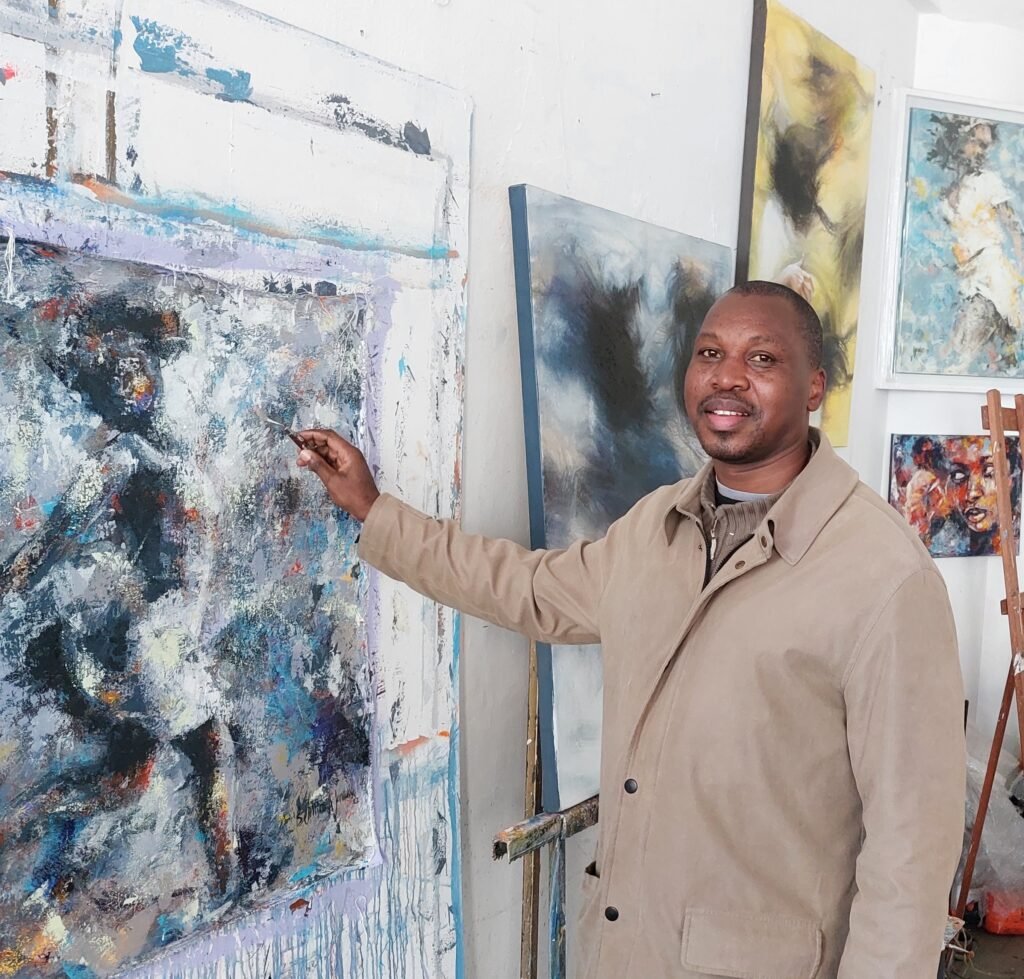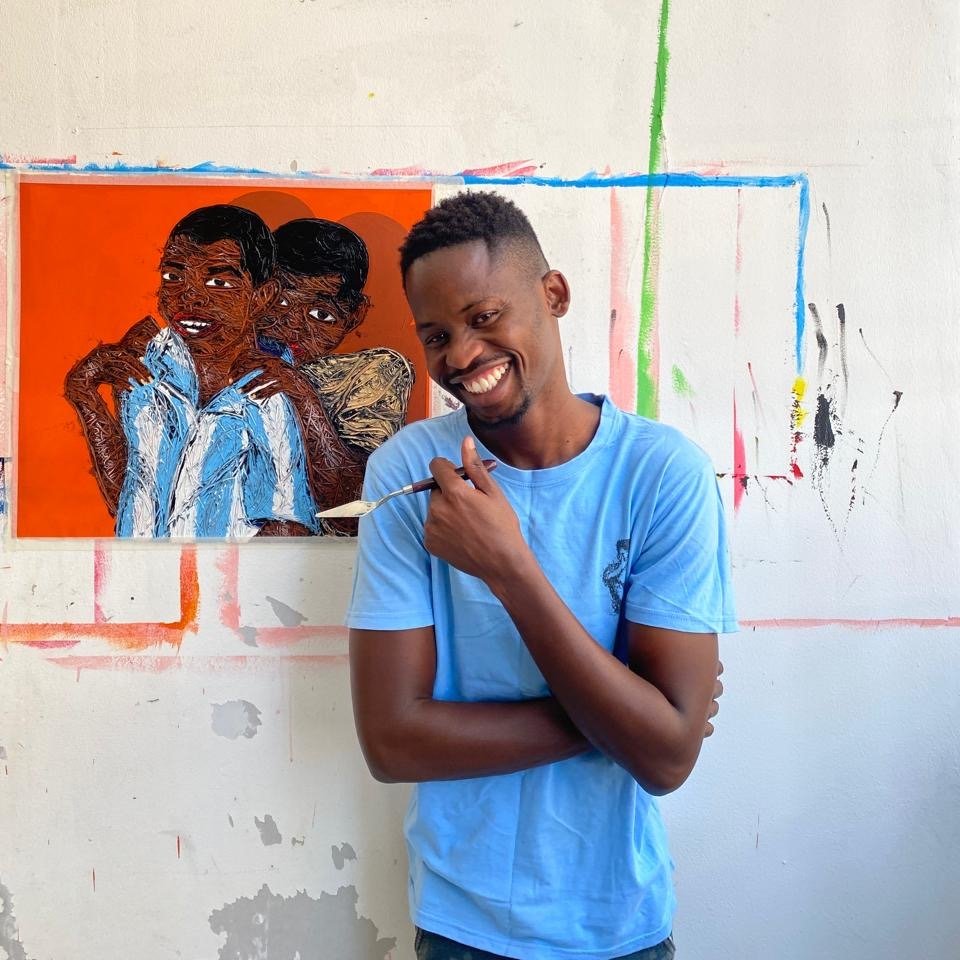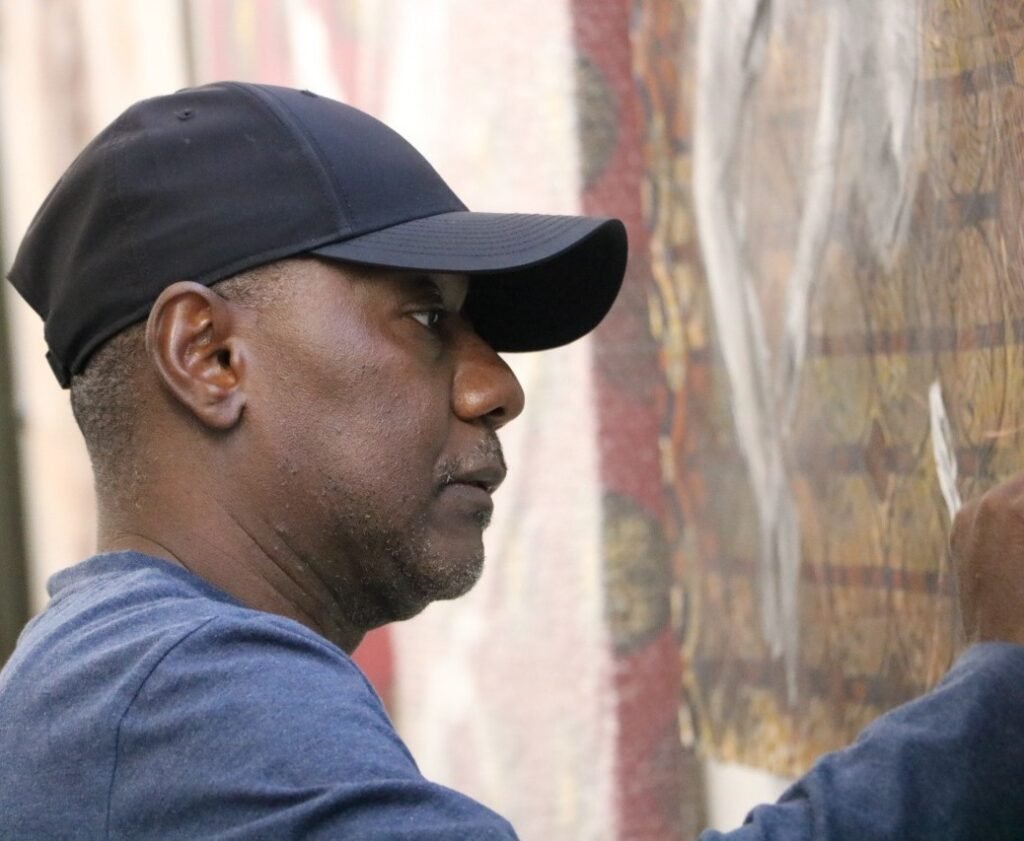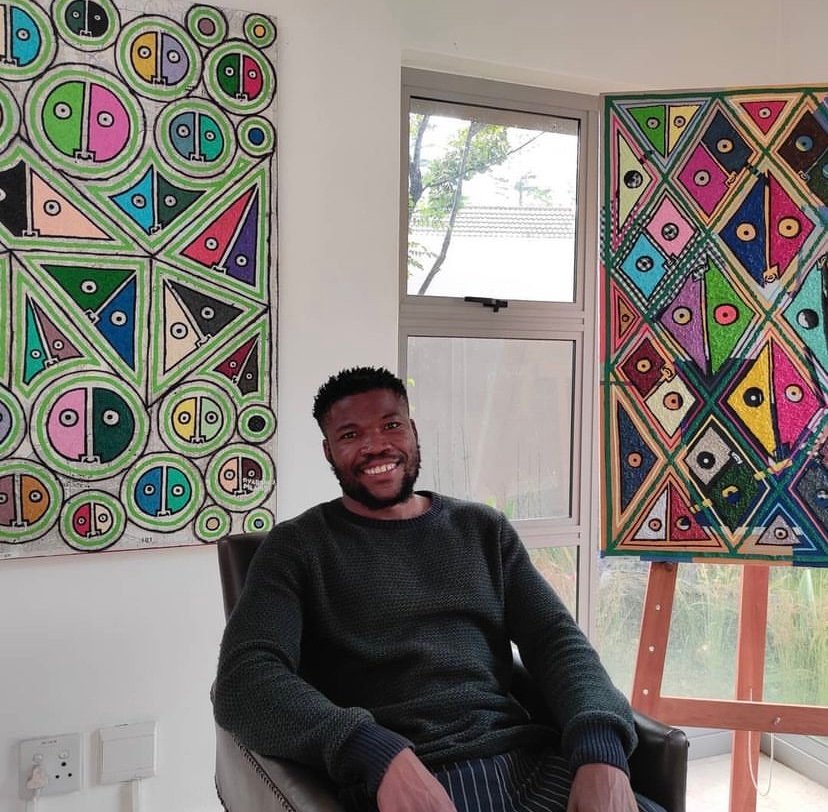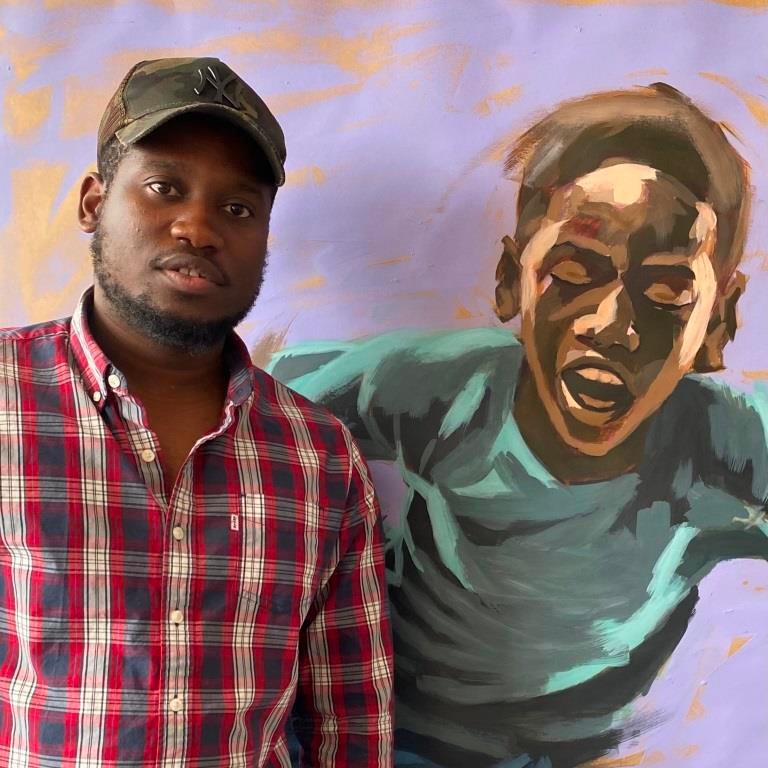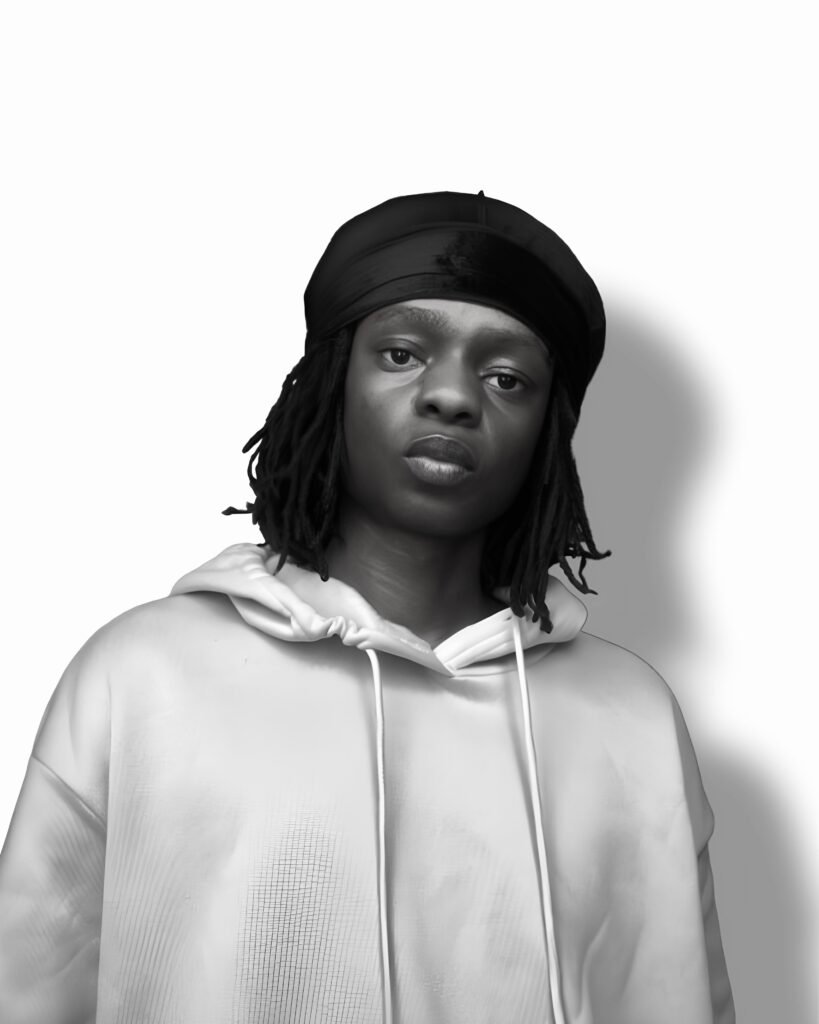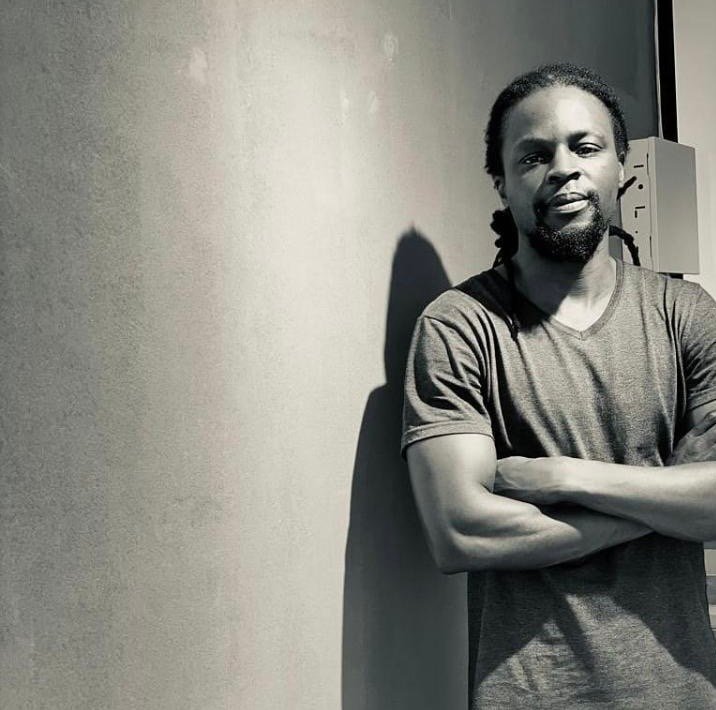
Cassius Kumalo
On Auction
Cassius Kumalo: A Journey Rooted in Culture, Music, and Ritual
Cassius Kumalo is a Johannesburg-based artist from Alexandra whose creative journey has been shaped by both his cultural heritage and his deep connection to music. As an artist, Kumalo has dedicated himself to exploring African knowledge, rituals, and traditions, using his art to connect the urban and rural experiences of Africa. His journey as an artist began at a young age, and it was his time at Artist Proof Studio that helped solidify his path in the art world. Through exposure to renowned artists and an emphasis on technical development, Kumalo’s artistic practice grew in both depth and purpose.
Early Life and Artistic Beginnings
Kumalo’s early life in Alexandra, one of Johannesburg’s oldest townships, was rich in cultural influences that would later inform his work. Growing up in a vibrant community, he developed a keen interest in the traditional customs, rituals, and stories that connected people to their ancestors and the land. From a young age, Kumalo had a natural inclination toward art, though it was not until he entered Artist Proof Studio that he realized the full potential of his creative abilities.
Artist Proof Studio was a transformative experience for Kumalo, offering him not only technical training in printmaking but also an environment where he could engage with other artists and learn from their journeys. Being surrounded by accomplished artists such as Philemon Hlungwani and William Kentridge, both of whom have had significant impacts on South African art, Kumalo absorbed lessons not just in technique but in the philosophy of artmaking. The opportunity to witness how these artists evolved was a privilege that deeply influenced his own development as an artist. It was at Artist Proof that Kumalo began to see the world of art as a map of sorts, where each piece of work and each creative decision contributed to a larger universal narrative.
The Influence of Music on Kumalo’s Work
Music plays a crucial role in Kumalo’s artistic practice, serving as both an emotional and conceptual framework for his work. Growing up, he was deeply influenced by rock music, with legends such as Jimi Hendrix and Miles Davis fuelling his imagination. These musicians, known for their innovative approaches and boundary-pushing soundscapes, became metaphors for the kind of artist Kumalo aspired to be: one who was not afraid to experiment, take risks, and explore new territories. The improvisational nature of jazz and the rebellious spirit of rock were qualities Kumalo admired and sought to incorporate into his art.
While his work is rooted in African traditions and knowledge, the relationship between music and art in Kumalo’s practice reflects a fluidity and openness that mirrors the dynamic nature of sound. The rhythms and harmonies of the music that inspired him can be seen in the layering of materials and forms in his visual art. His work, like a good jazz composition, is a continuous process of exploration, where each element is in dialogue with the other, creating a complex and resonant whole.
African Knowledge, Custom, and Rituals
Kumalo’s work is deeply informed by his connection to African customs and rituals. He sees himself as a “man of custom,” one who participates in rituals that link him to the ancestral world. This connection to ritual is central to Kumalo’s understanding of himself as an African artist. He believes that art is not only about personal expression but also about the collective memory and shared experiences of African people. Through his practice, Kumalo seeks to honour the customs, knowledge, and spiritual practices that have been passed down through generations, using his art as a bridge between the urban and rural experiences of African life.
A key aspect of Kumalo’s work is his belief in the power of rituals to connect people across time and space. He views these rituals as a means of bonding all Africans, regardless of geographical or cultural differences. His art reflects the unity and continuity of African traditions, focusing on themes of ancestral connection, spirituality, and the transformative power of culture. Kumalo is fascinated by the idea that African customs—whether in rural or urban contexts—serve as a cohesive force, binding individuals to their heritage and to each other. Through his artwork, he aims to communicate this sense of unity, using visual metaphors and symbolism to evoke the collective experience of African people.
The Symbolism of the Extra Finger
An intriguing aspect of Kumalo’s life and work is his birth with six fingers on one hand. In his culture, it is believed that individuals born with extra fingers are destined to have prosperous and flourishing lives. This belief became a significant part of Kumalo’s artistic narrative. The extra finger serves as both a personal symbol of potential and a cultural reference point, representing the idea that anything Kumalo touches—be it an artistic creation or a life endeavours—has the capacity to thrive. This belief in the power of the extra finger is embedded in his art, where every piece he creates is imbued with the potential to grow and evolve.
The story of his extra finger is more than just a personal anecdote; it is a cultural motif that speaks to the power of belief and the role of ritual in shaping one’s destiny. Kumalo’s connection to this belief system not only informs his personal life but also plays a key role in the way he approaches his art. It instils in him a sense of purpose and a belief in the transformative potential of his work, which he sees as a conduit for the flourishing of African culture, knowledge, and traditions.
Chalk Pastel: A Medium for Connection and Expression
Kumalo’s artistic medium of choice is chalk pastel, a tool that he feels allows him to express both his personal and cultural narratives in a direct and vivid manner. After years of working with printmaking, Kumalo felt that something was missing in his creative expression. It was the tactile and spontaneous nature of chalk pastel that drew him in, providing a more immediate connection to his work. Chalk pastel, with its ability to be layered and manipulated, offers Kumalo a way to create works that are rich in texture, colour, and meaning.
The fluidity of chalk pastel, combined with its vibrant colours, allows Kumalo to express the complexity of his ideas—particularly those related to African knowledge, ritual, and the interconnectedness of all things. He uses this medium to explore themes of spiritual connection, ancestral guidance, and the ritualistic practices that shape African life. The medium’s flexibility allows him to experiment with abstract forms, creating works that evoke the energy and movement of ritual while also grounding them in the everyday experiences of African people.
The Universal Map: Art as a Conduit for Connection
Kumalo believes that art is not just a personal journey but a universal one, with each work acting as a map of the universe. His art serves as a guide, not only for his own self-discovery but also for others who engage with it. He sees his work as part of a larger cosmic order, where everything is interconnected—much like the ancestral rituals that bind Africans to one another and to the land. This holistic view of art and its purpose informs Kumalo’s creative process. For him, each piece of art is a small part of a much larger whole, contributing to the broader conversation about culture, knowledge, and identity.
Kumalo is also deeply aware of the role that art plays in the larger societal context. He believes that art has the power to connect people across boundaries, whether those boundaries are geographical, cultural, or spiritual. Through his work, Kumalo hopes to foster a sense of unity and understanding among people, drawing on the rituals and customs that unite African people in both urban and rural settings. His art is not just a personal expression; it is a shared experience that invites others to reflect on their own connections to culture, history, and the world around them.
The Future: A Continued Journey of Exploration
As Kumalo looks to the future, he is deeply committed to continuing his artistic journey and further exploring the intersections of tradition, knowledge, and personal expression. He views the future as a dynamic and interconnected process, one where everything—art, culture, the universe—is constantly in flux and evolution. For Kumalo, art is a continual process of growth and discovery, with each piece contributing to his larger understanding of himself and the world.
His deep connection to African rituals, music, and cultural practices will undoubtedly continue to inform his work, as he seeks to bridge the gap between the urban and rural, the past and the future. Kumalo is not only focused on his own artistic development but also on the way his work can inspire others to connect with their own heritage and creative expression. His art serves as both a personal exploration and a universal map, guiding him—and others—toward a deeper understanding of the interconnectedness of all things.
Conclusion
Cassius Kumalo’s artistic journey is one of continuous exploration, driven by a deep connection to his cultural heritage, the music that inspires him, and the rituals that shape his understanding of the world. From his time at Artist Proof Studio, where he was exposed to the work of South Africa’s leading artists, to his current practice in chalk pastel, Kumalo’s art reflects his belief in the interconnectedness of all things. Through his work, he seeks to explore the rich traditions of African culture while also looking toward the future, where art serves as a bridge between generations, geographies, and spiritual realms. For Kumalo, art is more than a profession—it is a path to understanding the universe and his place within it.

